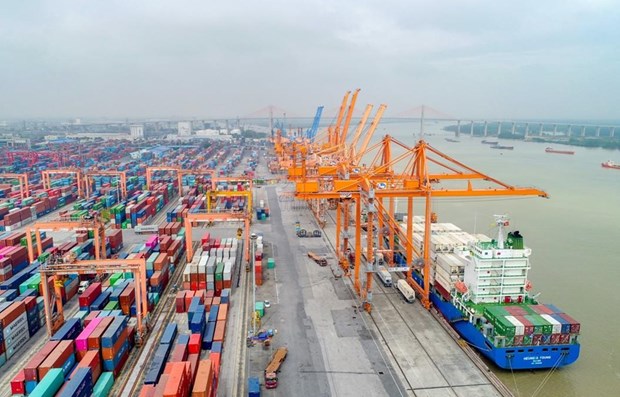Minister urges rolling out red carpet for investors in seaports
 Seaports play a significant role in international goods transportation. (Photo: VietnamPlus)
Seaports play a significant role in international goods transportation. (Photo: VietnamPlus) Hanoi (VNA) – Minister of Transport Nguyen Van The on October 7 said localities should coordinate with the ministry to roll out red carpet for investors in seaports, helping to create socio-economic breakthroughs.
He made the suggestion while speaking at an online conference held by the Ministry of Transport to announce the master plan on developing the domestic seaport network for 2021-2030, with a vision towards 2050.
The minister said he will propose typical mechanisms to the Prime Minister for approval so that investors can access capital, thus diversifying investment resources in the sector.
 Minister of Transport Nguyen Van The speaks at the meeting. (Photo: VietnamPlus)
Minister of Transport Nguyen Van The speaks at the meeting. (Photo: VietnamPlus) According to Deputy Minister of Transport Nguyen Xuan Sang, while drafting the plan, the ministry closely coordinated with and consulted other ministries, agencies and localities, along with experts and scientists to ensure synchrony between seaport planning and relevant national planning schemes.
The master plan has been approved by the Prime Minister under Decision No. 1579/QD-TTg dated September 22, he said, adding that the document is significant as it solidifies socio-economic development strategies and the maritime economic development strategy, helping to meet the country’s development demands for 2021-2030.
The plan gives priority to upgrading the system of seaports in the northern city of Hai Phong, with the aim of turning Lach Huyen into a port serving container cargo, along with the port clusters in Thanh Hoa, Da Nang and Khanh Hoa in the central region, and Cai Mep (Ba Ria-Vung Tau) and Tran De (Soc Trang) in the south.
Under the plan, priority will also be given to international gateway ports, large-scale seaports and those serving tourism development and industrial parks.
Up to 95 percent of about 313 trillion VND (nearly 13.8 billion USD) needed for the plan’s implementation will be mobilised outside the State budget.
Vietnam’s seaports are set to handle about 1.14-1.42 billion tonnes of cargo, including 38-47 million TEUs of container goods. They will be able to welcome 10.1 – 10.3 million passengers annually by 2030, according to the master plan.
Under the master plan, Vietnam aims to develop a uniform system of modern seaports that provide high-quality services, meet needs for socio-economic development, and ensure national security and defence, maritime safety and environmental protection. They will also improve the economy’s competitiveness. It is expected to help the country fulfill its goal of becoming an upper-middle-income developing country with modern industry by 2030.
The plan classifies Vietnamese seaports into five groups based on their geographical locations. The first group includes five northern ports in Hai Phong, Quang Ninh, Thai Binh, Nam Dinh and Ninh Binh. They are set to handle 305-357 million tonnes of cargo and 162,000-164,000 passengers by 2030, with an annual growth of 5-5.3 percent and 1.5-1.6 percent, respectively, by 2050.
The second group consists of six ports in the north central region, namely Thanh Hoa, Nghe An, Ha Tinh, Quang Binh, Quang Tri and Thua Thien-Hue; while the third one features eight ports in the south central provinces of Da Nang, Quang Nam, Quang Ngai, Binh Dinh, Phu Yen, Khanh Hoa, Ninh Thuan and Binh Thuan.
The fourth group comprising five ports in Ho Chi Minh City and the southern provinces of Dong Nai, Ba Ria-Vung Tau, Binh Duong and Long An are set to handle the largest share of cargo volume – from 461-540 million tonnes – by 2030. The goods volume going through the ports is forecast to grow 3.5-3.8 percent by 2050.
The last one consists of 12 ports in the Mekong Delta city of Can Tho and provinces of Dong Thap, Tien Giang, Vinh Long, Benh Tre, An Giang, Hau Giang, Soc Trang, Tra Vinh, Ca Mau, Bac Lieu and Kien Giang. They will focus on serving passenger transport with 6.1 – 6.2 million annually by 2030, the largest among the five groups.
Vietnam also plans to develop its network of railways and expressways to enhance connectivity between the Hai Phong and Ba Ria-Vung Tau Ports, categorised as special class, and other ports nationwide./.













